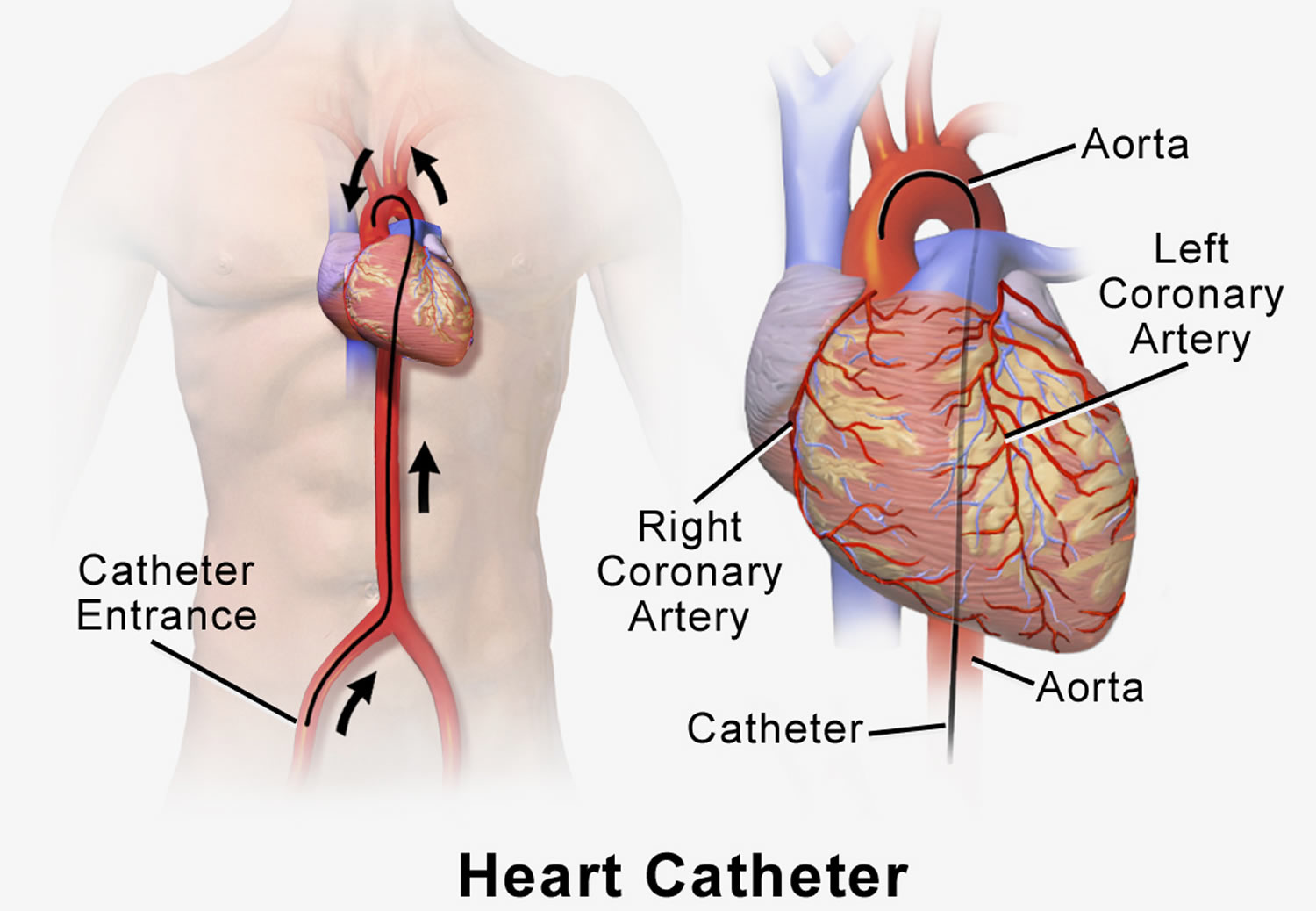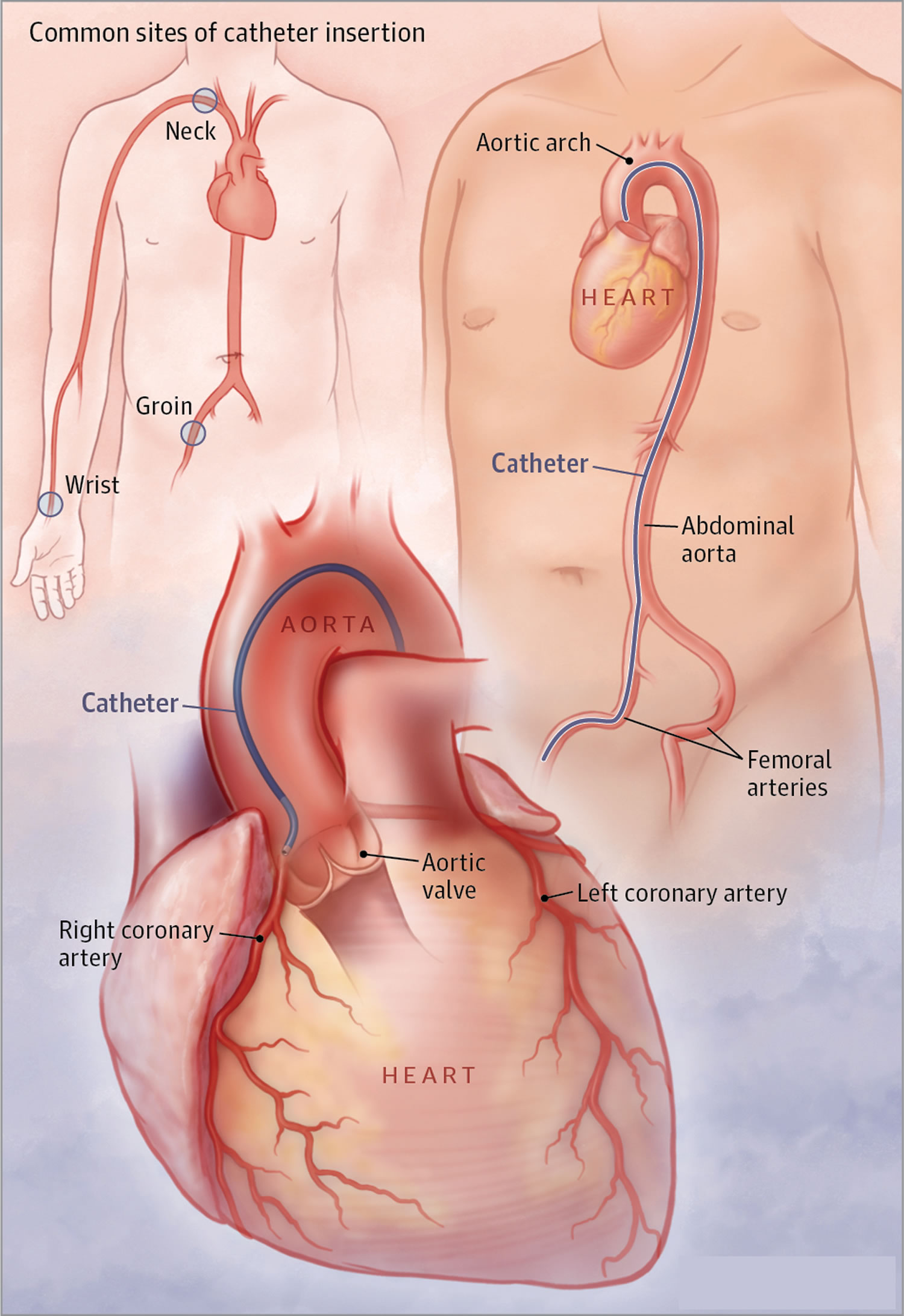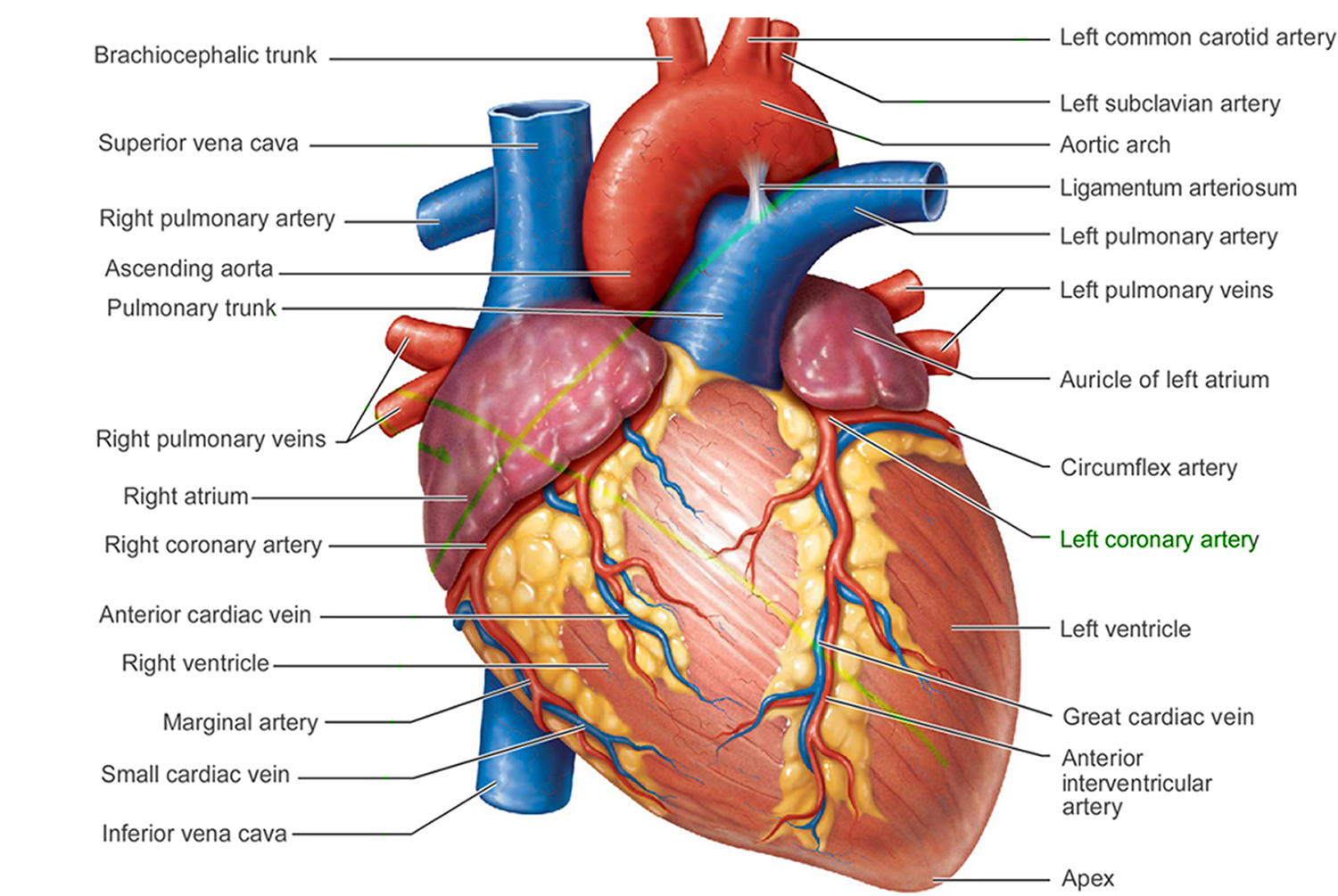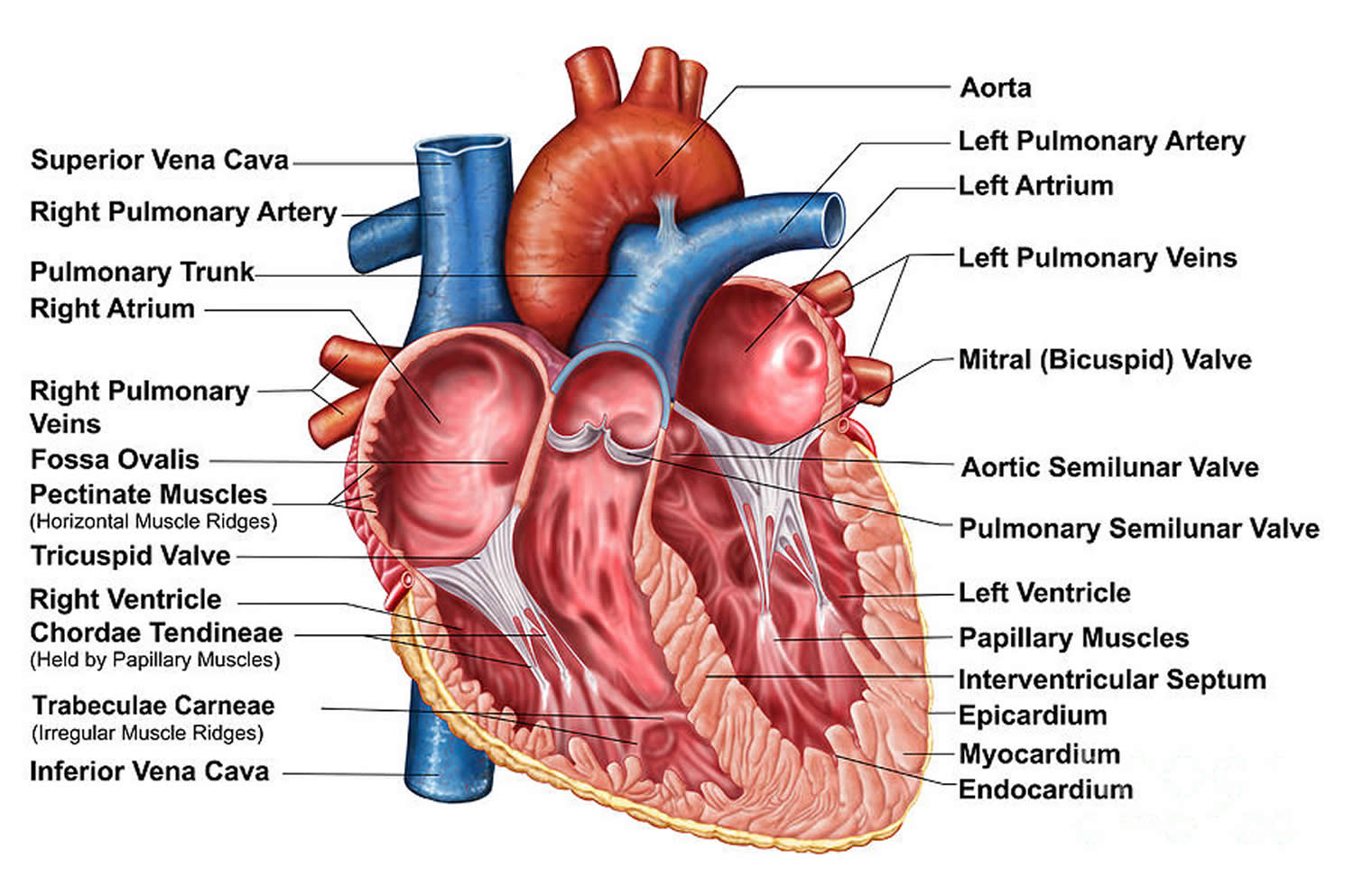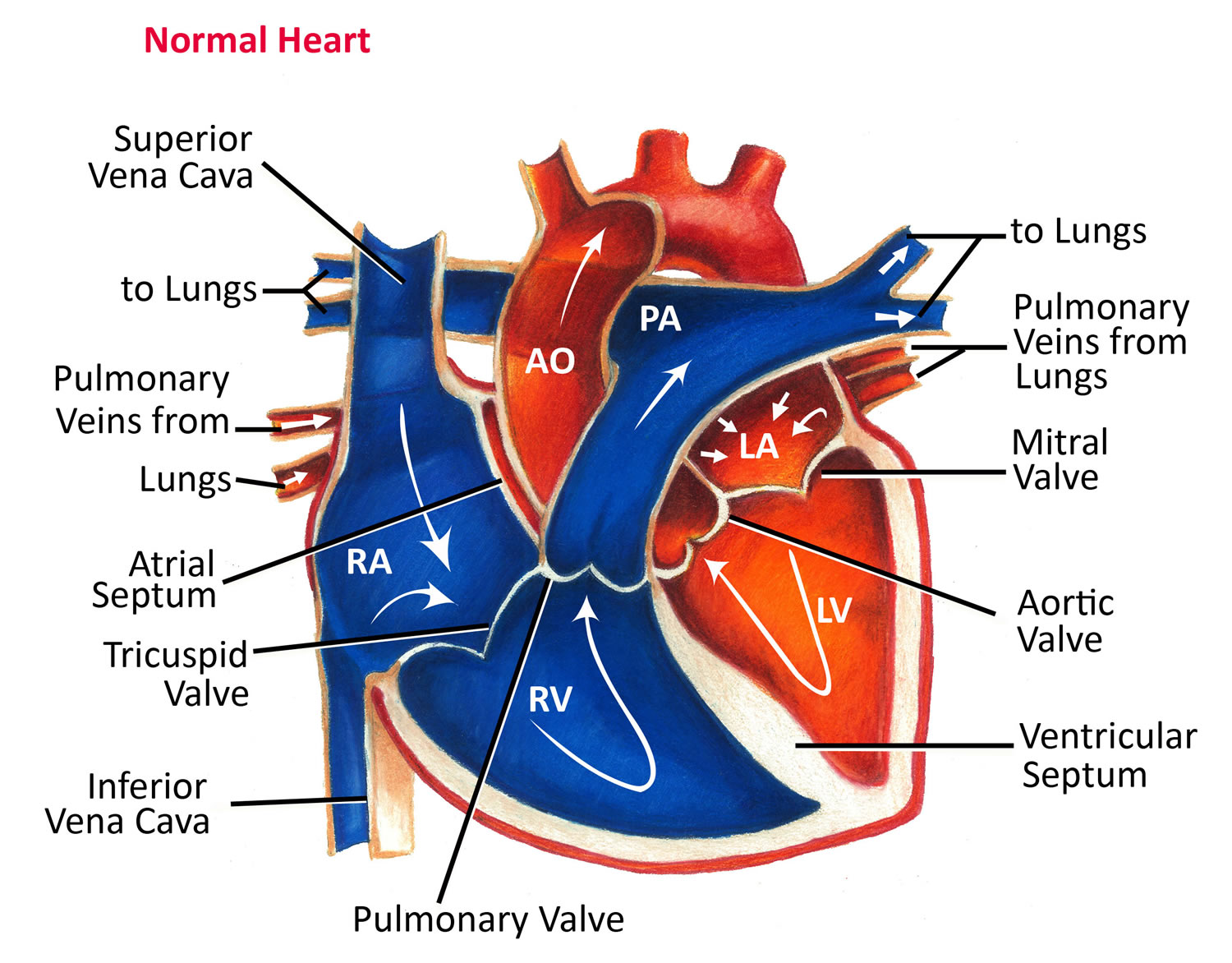Contents
What is cardiac catheterization
Cardiac catheterization also called cardiac cath or heart cath test, is a medical procedure that examines the inside of your heart’s blood vessels using special X-rays called angiograms. Cardiac catheterization is also used to treat some heart conditions. During a heart cath procedure, dye visible by X-ray is injected into blood vessels using a long, thin, flexible tube called a catheter, that is put into a blood vessel in your arm, groin (upper thigh), or neck and threaded to your heart. Through the catheter, your doctor can do diagnostic tests and treatments on your heart.
The heart cath test can measure the pressure and oxygen levels in the different chambers of the heart, determine the amount of blood pumped by the heart, find heart defects that have been present since birth, and help diagnose heart valve problems.
For example, your doctor may put a special type of dye in the catheter. The dye will flow through your bloodstream to your heart. Then, your doctor will take x-ray pictures of your heart. The dye will make your coronary (heart) arteries visible on the pictures. This test is called coronary angiography.
Coronary angiography is often performed as part of cardiac catheterization to help find blockages in the arteries that supply blood to the heart muscle. If a significant blockage is found, a doctor may be able to treat it by inflating a tiny balloon in the artery and then placing a small metallic tube called a stent to keep the vessel propped open.
The dye can show whether a waxy substance called plaque has built up inside your coronary arteries. Plaque can narrow or block the arteries and restrict blood flow to your heart.
The buildup of plaque in the coronary arteries is called coronary heart disease or coronary artery disease.
Doctors also can use ultrasound during cardiac catheterization to see blockages in the coronary arteries. Ultrasound uses sound waves to create detailed pictures of the heart’s blood vessels.
Doctors may take samples of blood and heart muscle during cardiac catheterization or do minor heart surgery.
Cardiologists (heart specialists) usually do cardiac catheterization in a hospital. You’re awake during the procedure, and it causes little or no pain. However, you may feel some soreness in the blood vessel where the catheter was inserted.
Cardiac catheterization is a commonly performed and generally very safe procedure. The most common problems after cardiac catheterization are bruising and tenderness at the puncture site.
Rare but more serious risks due to cardiac catheterization include significant bleeding or blood vessel injury, allergic reaction, kidney injury, stroke, heart attack, or death 1. You should discuss these risks as well as the benefits of the procedure with your doctor prior to the test.
Figure 1. Cardiac catheterization
Figure 2. The anatomy of the heart
Figure 3. The anatomy of the heart chambers
Figure 4. Normal heart blood flow
How long does a heart cath take?
A cardiac catheterization takes about 45 minutes to complete 2. However, the heart cath test may last 30 to 60 minutes. If you also need special procedures, the heart cath test may take longer. If the catheter is placed in your groin, you will often be asked to lie flat on your back for a few to several hours after the test to avoid bleeding.
Why the cardiac catheterization test is performed?
This procedure is most often done to get information about the heart or its blood vessels. It may also be done to treat some types of heart conditions, or to find out if you need heart surgery.
Your doctor may perform cardiac catheterization to diagnose or evaluate:
- Cardiac amyloidosis
- Causes of congestive heart failure or cardiomyopathy
- Coronary artery disease
- Heart defects that are present at birth (congenital)
- High blood pressure in the lungs (pulmonary hypertension)
- Problems with the heart valves
The following procedures may also be done using cardiac catheterization:
- Repair certain types of heart defects
- Open a narrowed (stenotic) heart valve
- Open blocked arteries or grafts in the heart (angioplasty with or without stenting)
Who needs cardiac catheterization?
Doctors may recommend cardiac catheterization for various reasons. For example, cardiac catheterization can help a doctor diagnose and manage heart valve problems, congestive heart failure, or pulmonary hypertension (high blood pressure in the lungs). Cardiac catheterization with coronary angiography is commonly performed in patients who are having a heart attack or experiencing chest pain that is not relieved with medications or who have an abnormal stress test result.
The most common reason for cardiac catheterization is to evaluate chest pain.
Chest pain might be a symptom of coronary heart disease (coronary artery disease). Cardiac catheterization can show whether plaque is narrowing or blocking your coronary arteries.
Doctors also can treat coronary heart disease during cardiac catheterization using a procedure called percutaneous coronary intervention, also known as coronary angioplasty.
During percutaneous coronary intervention, a catheter with a balloon at its tip is threaded to the blocked coronary artery. Once in place, the balloon is inflated, pushing the plaque against the artery wall. This creates a wider path for blood to flow to the heart.
Sometimes a stent is placed in the artery during percutaneous coronary intervention. A stent is a small mesh tube that supports the inner artery wall.
Most people who have heart attacks have narrow or blocked coronary arteries. Thus, cardiac catheterization might be used as an emergency procedure to treat a heart attack. When used with percutaneous coronary intervention, the procedure allows your doctor to open up blocked arteries and prevent further heart damage.
Cardiac catheterization also can help your doctor figure out the best treatment plan for you if:
- You recently recovered from a heart attack, but are having chest pain
- You had a heart attack that caused major heart damage
- You had an ECG (electrocardiogram), stress test, or other test with results that suggested heart disease
Cardiac catheterization also might be used if your doctor thinks you have a heart defect or if you’re about to have heart surgery. The procedure shows the overall shape of your heart and the four large spaces (heart chambers) inside it. This inside view of the heart will show certain heart defects and help your doctor plan your heart surgery.
Sometimes doctors use cardiac catheterization to see how well the heart valves work. Valves control blood flow in your heart. They open and shut to allow blood to flow between your heart chambers and into your arteries.
Your doctor can use cardiac catheterization to measure blood flow and oxygen levels in different parts of your heart. He or she also can check how well a man-made heart valve is working and how well your heart is pumping blood.
If your doctor thinks you have a heart infection or tumor, he or she may take samples of your heart muscle through the catheter. With the help of cardiac catheterization, doctors can even do minor heart surgery, such as repair certain heart defects.
Cardiac catheterization procedure steps
Cardiac catheterization is performed in an operating or procedure room that has specialized x-ray equipment. You may receive sedating medication but will usually be awake during the procedure. Your doctor administers local anesthetic to numb the site over the blood vessel (this is typically in the groin, wrist, or neck). Once the site is numb, the doctor uses a needle to help place a plastic tube called a sheath into the blood vessel. He or she then inserts a long, thin tube (catheter) and advances the catheter toward the heart using x-ray imaging for guidance. The catheter can be used to measure pressure, take blood samples, or perform a coronary angiogram by injecting dye to allow the doctor to examine the arteries of the heart. After the procedure is completed, the catheters and sheaths are removed. Pressure is held at the site of the puncture to prevent bleeding, or a specialized device is used to close the hole in the artery area and to aid in healing.
Before cardiac catheterization
Before having cardiac catheterization, discuss with your doctor:
- How to prepare for the heart cath procedure
- Any medicines you’re taking, and whether you should stop taking them before the procedure
- Whether you have any conditions (such as diabetes or kidney disease) that may require taking extra steps during or after the procedure to avoid problems
Tell your doctor if you:
- Are allergic to seafood or any medicines
- Have had a bad reaction to contrast dye or iodine in the past
- Take any medicines, including Viagra or other drugs for erectile dysfunction
- Might be pregnant
Your doctor will let you know whether you need to arrange for a ride home after the procedure.
Cardiac catheterization is most often performed after completion of a history and physical examination and noninvasive cardiac testing such as an ECG (electrocardiogram), echocardiogram, or stress test to evaluate symptoms. Such symptoms commonly include chest pain (referred to as angina), shortness of breath, fatigue, dizziness, or palpitations. In addition to providing a roadmap of the coronary arteries, cardiac catheterization can help to determine how well the valves in between the chambers of the heart are working and how well the heart muscle is pumping.
Cardiac catheterization provides definitive confirmation of narrowing in the coronary arteries and may also exclude the presence of coronary artery disease before heart valve surgery or other major surgery. If significant coronary blockages are present, angioplasty, or stenting (also known as percutaneous coronary intervention) can be performed, often during the same procedure, to improve blood flow to the heart muscle and help to relieve symptoms. This procedure may also be performed emergently for persons with suspected heart attack to identify blood clots in the coronary arteries and rapidly restore blood flow to the heart muscle.
What to expect before the cardiac catheterization
Typically, you may eat and drink up until midnight before the day of the catheterization. On the morning of the test, you can take most routine medications, including aspirin, clopidogrel, prasugrel, or ticagrelor, with a sip of water. Certain oral anticoagulation medications, such as warfarin (Jantoven or Coumadin) or dabigatran (Pradaxa), or any injectable anticlotting drugs should be held as directed by the managing clinician.
If you have diabetes mellitus, any oral diabetes medications should be held the night before and the morning of the procedure, and you may be instructed to adjust your insulin dose. Your blood sugar will be closely monitored during your hospital stay. If you have previously experienced an allergic reaction to contrast dye or if you have impaired kidney function, you should notify your physician to inquire about pretreatment.
Once at the hospital, you will change into a gown and have an intravenous line started in your arm. The hair on your wrist, arm, or legs will typically be shaved. Staff will review your medical history and answer questions from you and your family. After discussion and review of a form outlining details and risks of the procedure, you will be asked to sign to provide your consent.
During cardiac catheterization procedure
Cardiac catheterization is done in a hospital. During the cardiac catheterization, you’ll be kept on your back and awake. A specialized team of technologists and nurses will help to position you flat on an x-ray table in the catheterization laboratory. This allows you to follow your doctor’s instructions during the procedure. You’ll be given a mild sedative to help you relax, which might make you sleepy.
The entry point(s) is washed with a cool antiseptic soap, and your doctor will numb the area on the arm, groin (upper thigh), or neck where the catheter will enter your blood vessel with a local anesthetic, causing a temporary stinging sensation. Then, a needle will be used to make a small hole in the blood vessel. Your doctor will put a tapered tube called a sheath through the hole.
For left heart catheterization and coronary angiography, the femoral artery in the leg has been the traditional access site. However, the radial artery in the wrist is being used more commonly because this approach offers greater patient comfort and may reduce bleeding risks 2.
Next, your doctor will put a thin, flexible guide wire through the sheath and into your blood vessel. He or she will thread the wire through your blood vessel to your heart.
Your doctor will use the guide wire to correctly place the catheter. He or she will put the catheter through the sheath and slide it over the guide wire and into the coronary arteries.
Special x-ray movies will be taken of the guide wire and the catheter as they’re moved into the heart. The movies will help your doctor see where to put the tip of the catheter.
When the catheter reaches the right spot, your doctor will use it to do tests or treatments on your heart. For example, your doctor may perform a percutaneous coronary intervention, also known as coronary angioplasty, and stenting.
During the procedure, your doctor may put a special type of dye in the catheter. The dye will flow through your bloodstream to your heart. Then, your doctor will take x-ray pictures of your heart. The dye will make your coronary (heart) arteries visible on the pictures. This test is called coronary angiography.
Coronary angiography can show how well the heart’s lower chambers, called the ventricles, are pumping blood.
When the catheter is inside your heart, your doctor may use it to take blood and tissue samples or do minor heart surgery.
To get a more detailed view of a blocked coronary artery, your doctor may do intracoronary ultrasound. For this test, your doctor will thread a tiny ultrasound device through the catheter and into the artery. This device gives off sound waves that bounce off the artery wall (and its blockage). The sound waves create a picture of the inside of the artery.
If the angiogram or intracoronary ultrasound shows blockages in the coronary arteries, your doctor may use percutaneous coronary intervention to treat the blocked arteries.
After your doctor does all of the needed tests or treatments, he or she will pull back the catheter and take it out along with the sheath. The opening left in the blood vessel will be closed up and bandaged.
A small weight might be put on top of the bandage for a few hours to apply more pressure. This will help prevent major bleeding from the site.
What to expect after cardiac catheterization
After the cardiac catheterization, the catheter is removed from the access site(s). Manual pressure is applied, and an internal plug or stitch may be used to close the blood vessel. If the leg was used, you will be required to lie flat, keeping the leg straight for several hours, during which you will need to use a bedpan or urinal. If the wrist or arm was used, you may sit up immediately and walk to the bathroom with assistance when awake and alert. A band on the wrist will maintain pressure, and wrist movement will be restricted for several hours. You may be given fluids intravenously and can eat and drink as tolerated. A nurse will monitor you closely during recovery and review discharge instructions. If angioplasty or stenting was performed, you may need to stay in the hospital overnight.
After cardiac catheterization, you will be moved to a special care area. You will rest there for several hours or overnight. During that time, you’ll have to limit your movement to avoid bleeding from the site where the catheter was inserted.
While you recover in this area, nurses will check your heart rate and blood pressure regularly. They also will check for bleeding from the catheter insertion site.
A small bruise might form at the catheter insertion site, and the area may feel sore or tender for about a week. Let your doctor know if you have problems such as:
A constant or large amount of bleeding at the insertion site that can’t be stopped with a small bandage
Unusual pain, swelling, redness, or other signs of infection at or near the insertion site
Talk to your doctor about whether you should avoid certain activities, such as heavy lifting, for a short time after the procedure.
Cardiac catheterization recovery
What you should do at home
Take the bandage off as instructed by the cardiologist, usually the day after the catheterization. Wetting the sticky parts of the bandage will help it come off. Then, dry the area and put a small adhesive bandage over the place where the catheter went in.
Gently wash the area with soap and water at least once a day. Then, cover it with a new adhesive bandage.
For 2–3 days, take sponge baths or short showers so that the area where the catheter went in does not get too wet. Avoid baths, hot tubs, and swimming, and don’t use any creams, lotions, or ointments on the area.
Self-care
In general, people who have angioplasty can walk around within 6 hours after the procedure. Complete recovery takes a week or less. Keep the area where the catheter was inserted dry for 24 to 48 hours. If the catheter was inserted into your arm, recovery is often faster.
If the doctor put the catheter in through your groin:
- Walking short distances on a flat surface is OK. Limit going up and downstairs to around twice a day for the first 2 to 3 days.
- DO NOT do yard work, drive, squat lift heavy objects, or play sports for at least 2 days, or until your health care provider tells you it is OK.
If the doctor put the catheter in your arm:
- DO NOT lift anything heavier than 10 pounds (4.5 kilograms). (This is a little more than a gallon of milk).
- DO NOT do any heavy pushing, pulling, or twisting.
For a catheter in your groin or arm:
- Avoid sexual activity for 2 to 5 days. Ask your doctor when it will be OK to start again.
- You should be able to return to work in 2 to 3 days if you DO NOT do heavy work.
- DO NOT take a bath or swim for the first week. You may take showers, but make sure the area where the catheter was inserted does not get wet for the first 24 to 48 hours.
You will need to take care of your incision.
- Your doctor will tell you how often to change your dressing.
- If your incision bleeds, lie down and put pressure on it for 30 minutes.
Many people take aspirin, often with another medicine such as clopidogrel (Plavix), prasugrel (Efient), or ticagrelor (Brilinta), after this procedure. These medicines are blood thinners, and they keep your blood from forming clots in your arteries and stent. A blood clot can lead to a heart attack. Take the medicines exactly as your provider tells you. DO NOT stop taking them without talking to your doctor.
You should eat a heart-healthy diet, exercise, and follow a healthy lifestyle. Your provider can refer you to other health experts who can help you learn about exercise and healthy foods that will fit into your lifestyle.
When to call your Doctor
Call your doctor if:
- There is bleeding at the catheter insertion site that does not stop when you apply pressure.
- Your arm or leg below where the catheter was inserted changes color, is cool to the touch, or is numb.
- The small incision for your catheter becomes red or painful, or yellow or green discharge is draining from it.
- You have chest pain or shortness of breath that does not go away with rest.
- Your pulse feels irregular — it is very slow (fewer than 60 beats a minute) or very fast (over 100 to 120 beats a minute).
- You have dizziness, fainting, or you are very tired.
- You are coughing up blood or yellow or green mucus.
- You have problems taking any of your heart medicines.
- You have chills or a fever over 101 °F (38.3 °C)
Cardiac catheterization risks
Cardiac catheterization is a common diagnostic procedure performed >2 million times per year in the United States with minimal risk 2. The most common risks of cardiac catheterization include bleeding or hematoma. Rare risks include reaction to contrast dye, impaired kidney function due to contrast dye, abnormal heart rhythm, and infection. Extremely rare complications (<1%) include heart attack, stroke, need for emergent cardiac surgery, and death 2.
Cardiac catheterization complications can include:
- Bleeding, infection, and pain at the catheter insertion site.
- Damage to blood vessels. Rarely, the catheter may scrape or poke a hole in a blood vessel as it’s threaded to the heart.
- An allergic reaction to the dye that’s used during coronary angiography.
Other, less common complications include:
- Arrhythmias (irregular heartbeats). These irregular heartbeats often go away on their own. However, your doctor may recommend treatment if they persist.
- Heart attack.
- Kidney damage caused by the dye used during coronary angiography.
- Blood clots that can trigger a stroke, heart attack, or other serious problems.
- Low blood pressure.
- A buildup of blood or fluid in the sac that surrounds the heart (cardiac tamponade). This fluid can prevent the heart from beating properly.
As with any procedure involving the heart, complications sometimes can be fatal. However, this is rare with cardiac catheterization.
The risks of cardiac catheterization are higher in people who are older and in those who have certain diseases or conditions (such as chronic kidney disease and diabetes).
